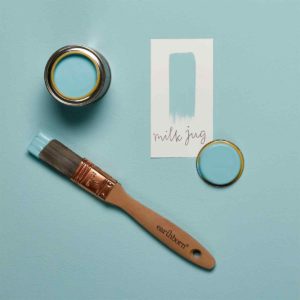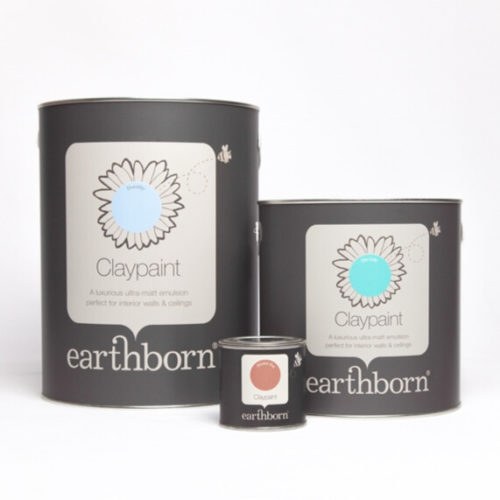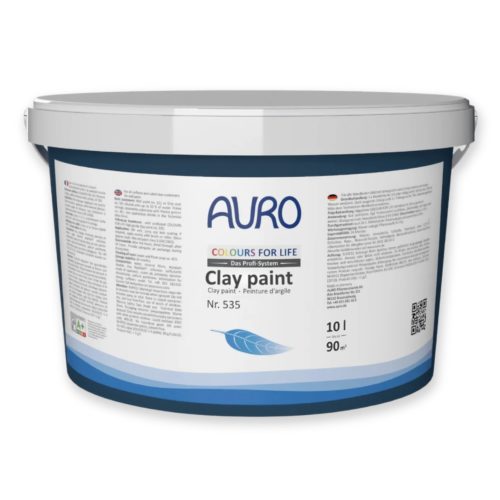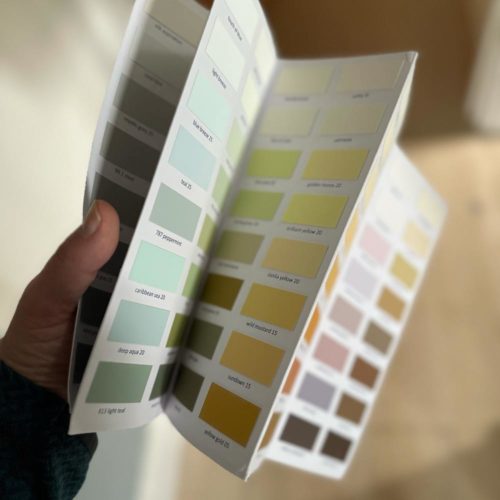Clay paint is a natural, breathable wall paint made using refined clays and mineral pigments. It offers a uniquely rich, ultra-matt finish that conventional paints can't replicate. Clay based paint is well suited to period homes and any property with solid walls that need to breathe.
As a completely natural water based paint with low or no VOCs, it appeals to eco-conscious homeowners and renovators seeking healthy homes and good
Unlike conventional emulsions, clay paint contains no acrylics, plastics, or oils. Its key ingredients include kaolin clay, chalk, and earth pigments. This gives it a dense, creamy texture that applies smoothly and covers well.
Clay paint combines aesthetics with performance. The soft matt finish gently reflects light to create a calm, soothing atmosphere, and the formulation is safe for allergy sufferers or those who are sensitive to harsh chemical fumes like those emitted by conventional paints.

What Surfaces Can Clay Paint Be Used On?
Clay paint is versatile and can be used on a range of interior surfaces, particularly those found in older or traditionally built homes where breathability is desirable.
Lime Plaster
Highly compatible with lime plasters once cured. Lime plaster is a breathable substrate and clay paint offers suitable breathability. No primer required; a mist coat may need to be applied for best results.
Gypsum Plaster
Clay paint can be used on gypsum plaster. Depending on the brand, a mist coat may be required on bare or stripped back plaster.
Previously Painted Surfaces
Clay paint can be suitable for application onto surfaces previously coated with different types of paint if the old paint is sound. Gloss or oil-based finishes may need sanding and priming.
Wood
Use on bare or previously painted wood with appropriate preparation. Results in a flat matt finish, but durability is slightly lower than dedicated wood paints.
Wallpaper
Wallpapers can be painted over, although clay paint may soften certain paper types. We'd always recommend a patch test to make sure the substrate is compatible with your clay paint.
Brick, Stone & Render
Interior masonry surfaces are generally suitable. Surfaces should be dry, dust-free, and absorbent.
Overall, clay paint is ideal for internal walls and ceilings in most domestic rooms, including bedrooms, living areas, hallways, and home offices. It offers a robust finish capable of withstanding day to day usage in your home.
However, clay paint might not be the best choice for:-
- Bathrooms or wet rooms with high humidity. We recommend you consider anti-mould or silicate based paint options instead.
- Kitchens where frequent wiping is required
- Areas prone to condensation or water contact
What is the Best Way to Apply Clay Paint?
Clay paint is simple to apply but does require some basic preparation for best results:
- Surface preparation: Ensure the surface is clean, dry, and dust-free. Porous surfaces may benefit from a mist coat (diluted first coat).
- Application tools: Brush, roller, or airless sprayer can be used. A short pile roller is typically recommended for an even finish.
- Technique: Work one wall at a time to maintain a wet edge and avoid lap marks. Clay paint dries quickly, so avoid over-brushing.
- Coverage: Varies by brand and substrate. Expect approximately 7-10m2 per litre.
- Drying time: Touch dry within a few hours; recoat after 6–12 hours depending on conditions. Full curing takes 10–14 days.
Clay Paint Texture – A Uniquely Rich Finish
Clay paint has a rich, dense consistency that dries to a soft, velvety matt finish. Unlike plastic-based paints, it doesn't reflect light harshly, instead giving walls a gentle, chalky quality that can enhance both natural and artificial lighting. Some formulations may reveal subtle brush strokes or colour variation that add to its character.
How Durable is Clay Paint?
Clay paint is reasonably durable for standard household use, especially when applied to a properly prepared surface. While not suitable for frequent scrubbing, it can be gently wiped clean once fully cured. It performs well in bedrooms, lounges, and other dry, low-traffic spaces.
Is clay paint washable?
Yes, clay paint is usually classed as washable after full curing, but this does not mean scrub-proof. It allows for light maintenance cleaning using a soft cloth and water, but harsh abrasion or chemicals may damage the surface. Clay paint may not be suitable for areas such as kitchens and bathrooms where a more wipeable surface may be required.
Can You Get Clay Paint in Colours?
Yes, clay paint is available in a wide range of natural, earthy and pastel tones. Most leading manufacturers offer dozens of pre-mixed colours inspired by mineral pigments. For example:
- Earthborn Claypaint offers over 70 shades, all VOC-free.
- Auro 535 is available in 96 beautiful tones.
You can order a free colour chart to see all clay paint colours from Earthborn & Auro.
Frequently Asked Questions
Is clay paint wipeable?
Yes, most clay paints are wipeable once fully cured (usually after 10–14 days depending on the manufacturer). They are not scrubbable like gloss or eggshell paints, but light marks can typically be removed with a damp cloth. For areas where heavy-duty cleaning is expected, a more durable paint type may be better suited. Both Auro and Earthborn offer wall glaze products which can be applied over clay paint to increase durability.
Can I use clay paint on lime plaster?
Absolutely. Clay paint is especially compatible with lime plaster because both materials are breathable. This makes clay paint an excellent choice for older or listed buildings where moisture movement through the walls is essential.
Can you spray clay paint?
Yes, some clay paints can be applied using a spray gun, though thinning with water may be required. Always check the specific product's technical datasheet for guidance on spray application. A short pile roller or brush is usually preferred for smaller areas or detailed work.
Is clay paint the same as chalk paint?
No. While both paints have a flat matt finish, clay paint is made from natural clays and mineral pigments and is typically more breathable and eco-friendly. Chalk paint tends to have a powdery residue and is often used for furniture projects, whereas clay paint is designed for walls and ceilings.
Can You Use Clay Paint Over Emulsion or Other Paint Types?
Yes, you can use clay paint over standard water-based emulsions, as long as the surface is sound, clean, and matte. Glossy, vinyl, or oil-based paints will need to be abraded or primed with a breathable bonding primer first. Always spot test before large-scale application.
Can You Use Clay Paint on Wood?
Clay paint can be used on interior wood, such as panelling or bare timber, provided the surface is properly prepared. The finish will be ultra-matt and chalky in appearance, but clay paint does not offer the durability or washability of dedicated wood paints.






